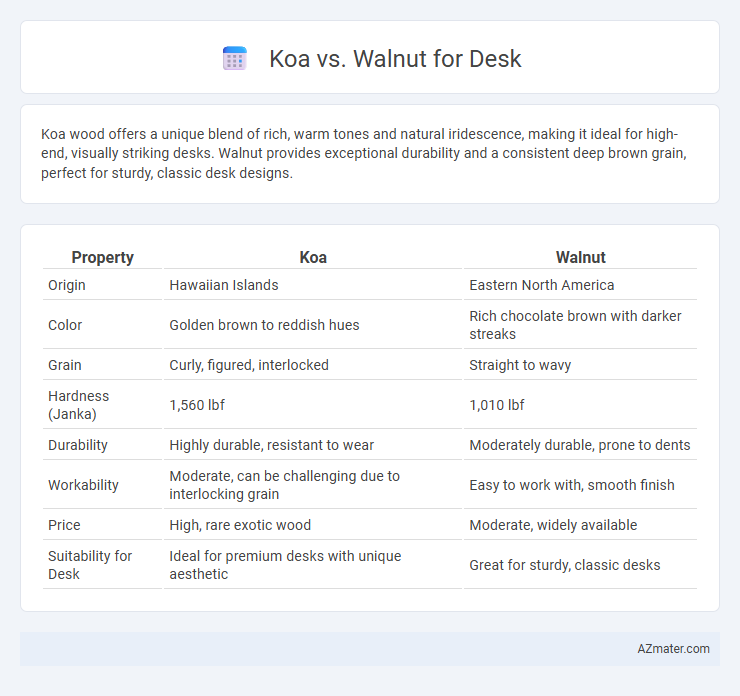Koa wood offers a unique blend of rich, warm tones and natural iridescence, making it ideal for high-end, visually striking desks. Walnut provides exceptional durability and a consistent deep brown grain, perfect for sturdy, classic desk designs.
Table of Comparison
| Property | Koa | Walnut |
|---|---|---|
| Origin | Hawaiian Islands | Eastern North America |
| Color | Golden brown to reddish hues | Rich chocolate brown with darker streaks |
| Grain | Curly, figured, interlocked | Straight to wavy |
| Hardness (Janka) | 1,560 lbf | 1,010 lbf |
| Durability | Highly durable, resistant to wear | Moderately durable, prone to dents |
| Workability | Moderate, can be challenging due to interlocking grain | Easy to work with, smooth finish |
| Price | High, rare exotic wood | Moderate, widely available |
| Suitability for Desk | Ideal for premium desks with unique aesthetic | Great for sturdy, classic desks |
Introduction to Koa and Walnut Wood
Koa wood, native to Hawaii, is prized for its rich, warm hues and striking grain patterns that range from golden browns to deep reddish tones, making it a luxurious choice for desk surfaces. Walnut wood, primarily sourced from North America and Europe, features a smooth texture with dark brown to purplish-black coloration, offering a sophisticated and durable option for desk craftsmanship. Both woods provide exceptional strength and stability, with koa known for its unique figure and walnut valued for its uniformity and ability to age gracefully over time.
Overview: Why Material Matters for Desks
Koa and walnut are premium hardwoods prized for their durability and distinctive grain patterns, making them ideal choices for high-quality desks. Koa offers a rich, warm color with complex figuring that enhances aesthetic appeal, while walnut provides a deep, consistent hue known for its strength and resistance to wear. Selecting the right material affects a desk's longevity, surface resilience, and overall workspace ambiance, ensuring both functionality and style in office furniture.
Koa Wood: Origins and Unique Characteristics
Koa wood, native to Hawaii, is renowned for its rich biodiversity and vibrant figure that ranges from golden brown to deep reddish hues, making it a prized choice for luxury desks. This hardwood combines remarkable density and durability with a natural luster, offering a smooth finish that showcases its unique swirling grain patterns. Koa's rarity and distinct aesthetic contribute to its high value and desirability in custom wood desk creations, setting it apart from commonly used species like walnut.
Walnut Wood: Source and Distinct Features
Walnut wood is predominantly sourced from American Black Walnut (Juglans nigra), prized for its deep, rich chocolate-brown color and striking grain patterns, often featuring purple hues and intricate swirls. Its density and natural oils provide durability and resistance to warping, making walnut an ideal choice for premium desks that combine strength with elegance. Distinct from koa, walnut offers a smoother finish with uniform texture, enhancing its appeal for sophisticated office environments and high-end furniture.
Durability Comparison: Koa vs Walnut
Koa wood offers exceptional durability with a high resistance to wear, moisture, and decay, making it suitable for long-lasting desk surfaces. Walnut provides strong durability as well, featuring a dense grain structure that withstands daily use and minor impacts effectively. When comparing durability, koa generally surpasses walnut in moisture resistance, while walnut excels in shock absorption and dent resistance for desk applications.
Aesthetic Appeal and Grain Patterns
Koa wood offers a rich, warm aesthetic with vibrant color variations ranging from golden honey to deep reddish-brown, featuring striking, curly, and interlocking grain patterns that create a luxurious, dynamic look for desks. Walnut is prized for its smooth, dark chocolate-brown hue and straight, fine grain with occasional waves, providing a sleek, modern, and sophisticated appearance. Both woods elevate desk design, with Koa delivering exotic visual interest and Walnut offering timeless elegance.
Workability and Finishing Differences
Koa wood offers excellent workability with its fine, straight grain and medium texture, making it easy to shape and sand for smooth finishes; it responds well to stains and polishes, enhancing its rich, golden-brown tones. Walnut, prized for its stability and uniform texture, has moderate workability but excels in achieving silky, dark finishes that highlight its chocolate-brown to purplish hues. Both woods finish beautifully but koa tends to showcase more vibrant grain patterns, while walnut provides a deep, elegant aesthetic favored in high-end desk craftsmanship.
Cost and Availability of Koa and Walnut
Koa wood is generally more expensive than walnut due to its limited availability, primarily sourced from Hawaii, which drives up transportation and harvesting costs. Walnut, especially black walnut, is more widely available across North America, resulting in a more affordable price point for desks. The rarity of koa makes it a premium choice for unique, high-end furniture, whereas walnut offers a balance of quality and cost-efficiency.
Environmental Impact and Sustainability
Koa wood, native to Hawaii, is prized for its rapid growth and ability to sequester carbon, promoting sustainable forestry when harvested responsibly. Walnut, often sourced from North American temperate forests, has a slower growth rate and greater ecological footprint due to longer maturation, making its sustainability more dependent on certified management practices. Choosing Koa for desks supports reforestation efforts and biodiversity conservation, whereas Walnut requires careful sourcing to minimize deforestation and habitat disruption.
Which Wood is Best for Your Desk?
Koa wood offers a rich, warm color with beautiful grain patterns, making it ideal for visually striking desks that stand out in any workspace. Walnut provides a darker, more uniform tone with excellent durability and resistance to wear, perfect for desks requiring both elegance and long-lasting performance. Choosing between Koa and Walnut depends on whether you prioritize unique aesthetics with Koa's vibrant hues or Walnut's consistent strength and classic look.

Infographic: Koa vs Walnut for Desk
 azmater.com
azmater.com